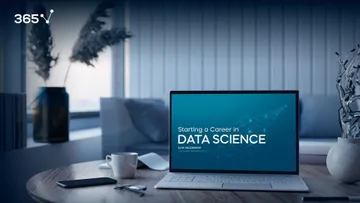Ever since the COVID-19 pandemic hit, there has been a massive shift in the job landscape. Remote work is on the rise, and many employees have started to realize the benefits of working from home.
If you are an aspiring data scientist, a full-time job isn’t your only career option. There are many opportunities for you to work remotely in this field. If you are successful, this is an opportunity to earn more, improve your work-life balance, and be your own boss.
Also, you aren’t restricted to a single problem. You can take up tasks in a variety of domains and gain exposure to the data science workflow in many different companies. This is a great value add to your resume, and you will find it easier to land a wider range of data jobs in the future. Finally, you are allowed to handpick what you want to work on tasks that you enjoy performing.
However, it is also an entrepreneurial journey. The competition is fierce with other individuals around the world who have chosen the same career path as you. It isn’t easy, especially at the beginning.
In this article, we will provide you with a guideline on becoming a freelance data scientist in 2025. We will walk you through the different types of roles you can take up, how to stand out among other freelancers in the industry, and how you can market yourself to get as many gigs as possible.
Table of Contents
- What Are the Prerequisites to Becoming a Freelance Data Scientist?
- How to Land Freelance Data Science Jobs?
- What Types of Freelance Data Science Jobs Are Available?
- How to Become a Freelance Data Scientist : Next Steps
What Are the Prerequisites to Becoming a Freelance Data Scientist?
Behind every successful venture lies research into the topic at hand. 365 Data Science’s co-founder and CEO, Ned Krastev, recommends that you consider your current situation first before beginning your journey into freelancing.
For example, are you currently in full-time employment? One of the first choices that you need to make is whether to keep your traditional job or to freelance around the clock. Both options have their pros and cons, and the optimal solution depends on your personal circumstances.
However, quitting your current job to pursue freelancing full-time isn’t the only possible option. Especially in the beginning, you can have a transition period during which you keep your 9-to-5, but also do some freelancing gigs on the side. This approach has 2 significant advantages:
- Testing the waters to see for yourself what it means to freelance. In fact, it is quite different than being a regular employee – as a freelancer, you have to be able to work autonomously and carry out a specific type of project work from end-to-end with limited to no management.
- Keeping your full-time employment for the moment allows you to gain some traction on freelancing platforms.
How to Land Freelance Data Science Jobs?
As we previously mentioned, starting as a freelancer in the data science industry can be difficult. The market is saturated, and it takes a lot of time and patience to successfully break into the industry when you’re on your own.
But we’re not here to be gatekeepers, rather we aim to provide some genuine advice on how to get started as a successful freelance data scientist.
Build a Data Science Portfolio That Stands Out
Freelancing is very different from a traditional full-time position. Because of the lack of job security, you need to constantly source for new opportunities. Also, keep in mind that there are other highly qualified data scientists competing for the same role as you are.
To stand out from the crowd, you need a portfolio that showcases your capability. If you created a data science project, share it with as many people as possible. Push your code to GitHub. Write a tutorial about it and publish it online.
As your projects garner more views, your chances of getting noticed by a potential employer increase. You are more likely to land a job this way than if you simply respond to open job listings.
Furthermore, you can even begin creating tutorials for other data scientists. Technical writing displays a high level of understanding of the subject material and are a good way of impressing your future clients. If video creation is a viable option for you, then starting your own YouTube channel can be very helpful as well. Finally, depending on your skills, you might want to get into Kaggle competitions, which will make great additions to your portfolio.
Create A Profile on Freelance Platforms
One of the best and most consistent ways to find freelance work is to build a successful profile on a globally renowned platform. Websites like Upwork, Toptal, and others can connect you with thousands of business owners around the world. Many of them are willing to pay top dollar for your services.
In this section, 365 Data Science’s Ned Krastev shares his advice on how to navigate these freelance platforms efficiently in order to glean success and build your client network.
How to Choose the Right Freelance Platform for Your Services?
Selecting the right platform for you is a very important decision. For example, if you opt for Fiverr, clients might expect you to deliver a bargain deal, which is far from ideal.
Therefore, Toptal and Upwork are probably the 2 best options.
There is a much higher volume of business on Upwork and freelancers tend to charge from 30 to a few hundred dollars per hour (for machine learning projects). Toptal, on the other hand, brings less deal flow, but might introduce you to high-end corporate clients that will stick with you in the long term.
While it makes sense to be listed on multiple platforms, perhaps it is optimal to focus on only one of them. Make sure all your marketing materials point to the same platform – this is where you want to build your following and move up the rankings. Essentially, splitting reviews isn’t a good practice.
How Do Freelance Platform Economics Work?
Buyers will search for top-rated talent with significant social proof. They will also look at your previous projects and try to assess whether you’re the right person for their current needs.
Someone who has previous work history related to data cleaning only will have a hard time getting model building tasks. So, you have to be mindful of:
- How many reviews and hours you have billed
- The type of projects you accept to work on
- The prices you’ve listed for your services
- How structured and well-written your description is – please try to be very specific and put emphasis on the type of projects you’ve worked on, as well as the results that you’ve delivered; include as many specific KPIs and measures as possible
- Make sure you have an excellent portfolio with data projects that support the services you’re offering.
How Do You Decide How Much to Charge for Your Data Science Services?
A very important question to ask is how much you should charge for if you’re just getting started. Don’t fall into the trap of selling yourself short. Instead, start with a higher list price, then bid on projects offered on the platform at a significant discount. This will increase the perceived value clients have of your services and allow you to gradually decrease discounts as you accumulate social proof.
And if you’re qualified, don’t hesitate to charge premium prices! Similarly to social proof, the price you’ve set for your services speaks of the quality of your work. Premium clients (who are the best customers) might be put off by low prices.
Gain Industry Experience
It will take some time before you get noticed on these platforms. There are many other data scientists offering the same services as you. You need to successfully complete a few jobs before your profile ranks highly and is visible to employers.
Due to this, you need to start out by looking for tasks that align with your skillset. If you find a suitable position, send out a proposal that clearly outlines how you’d be able to accomplish the task.
Tailor your resume to match the job description. Attach sample projects you’ve created that are similar to the task at hand and include links to your blog and LinkedIn page. Anything you feel might be relevant to your application will work in your favor and demonstrate to potential employers that you’ve got what it takes.
Build a Strong Social Media Presence
Marketing yourself is always helpful – but especially crucial in the beginning. Make sure to put in the effort to get noticed and win your first customers.
Remember, it isn’t easy to get your first few roles by relying on freelance platforms alone. This is a very saturated space, and there will be many other applicants bidding for the same job.
Due to this, it is important to continue promoting your work off-platform and building a social presence. Whenever you post about a new project you created, include a link to your Upwork handle. Pin this to your LinkedIn profile so that every time you connect with someone, they can see the freelance services you offer.
The more people that notice you at the beginning, the better your chances are of success.
Ask Employers to Leave Feedback on Your Profile
Your first few gigs are the most crucial. You are completely new to freelancing for data science, and you need to build a good reputation for yourself in the industry. Ask your employers to leave a review or feedback for you on the platform you are working on.
This will go a long way, as it provides other potential employers with the confidence that you are trustworthy and can get the job done.
What Types of Freelance Data Science Jobs Are Available?
Now that we’ve outlined how to find and prepare for freelancing as a data scientist, we’ll introduce you to the type of roles you might expect. There’s plenty you can take on, some as one-off projects, while others can be continuous collaborations – especially if you manage to impress your client.
Building Machine Learning Models
As a freelance data scientist, you can build models for organizations on a one-off basis. There are many companies out there that don’t require an entire data science team. Instead, they just need someone who can build machine learning models to solve specific problems using the data they have available. Our course The Machine Learning Process A-Z can help you understand the machine learning processes that you deal with in your line of work.
Here are a few examples of model-building tasks that companies outsource to freelancers:
Churn Prediction
Customer churn is a phenomenon that occurs when a client decides to stop doing business with an entity. Organizations often hire data scientists to build machine learning models that can predict when a customer is about to churn. This way, they are able to target these customers with special offers and promotions to keep them aboard.
If you’d like to read more about the role of data science in finance, read 365 Data Science’s dedicated article on how data changed the industry.
Recommender Systems
Recommender systems are designed to provide users with personalized recommendations based on their previous purchase behavior and activity.
Companies like Netflix, Spotify, and Amazon use recommender systems to provide each user with different browsing experiences.
The 365 Machine Learning with Naïve Bayes course is a great way to learn about one of the ways to build recommendation systems and overall improve your machine learning engineer skills.
Customer Segmentation
Organizations often keep track of their user’s transaction history and some basic information in a database. This data can be used to build customer profiles and come up with different targeting mechanisms for each user.
These are just a few examples of the kind of models you can be hired to build as a freelance data scientist. Data science use cases across most organizations are pretty similar, as companies that have a pipeline in place are all attempting to solve a consistent set of business problems. If you can learn how to build models such as the above and showcase some business intelligence skills on your portfolio, you can easily land a freelance job at one of these companies.
The 365 Customer Analytics in Python course is a great place to get started, as it teaches you to build machine learning models that are highly sought-after by organizations.
Writing Technical Data Science Tutorials
Data scientists are often hired by organizations to write articles and tutorials about the subject. If you’ve learned how to build machine learning models in Python, perform exploratory data analysis, or conduct some type of statistics, you can work for a publication that needs articles on these topics.
You can write and potentially start publishing your own articles on platforms like LinkedIn Pulse, Towards Data Science, KDNuggets, and 365 Data Science. This is a great way to enhance your own skills on the subject, and will help you to continuously stay on top of new technology. Plus, there’s an enormous amount of companies looking for technical writers for their blogs.
Keep in mind that data science tutorials need to be explained precisely and in a way that is easily digestible to the reader. You can only achieve this if you are familiar with a topic, so you need to do a ton of research and self-learning when working as a writer in the data science space. Therefore, this gig is more suitable for junior candidates.
Data Collection
There is a huge scope for individuals who can collect and store large amounts of data. Many companies don’t have internal data available and rely on external to make critical business decisions.
This can include data on social media platforms, product reviews, or market trends that they use to understand public demand.
This generally is a one-off task, but companies may reach out to you again for a refresh after some time. To perform tasks like automated data collection on a large scale, you should have a strong command of at least one programming language – we recommend Python.
You also need to know how to work with APIs and web scrapers to pull external data.
The 365 Web Scraping and API Fundamentals in Python course will teach you these data collection skills from scratch.
Market Analysis
Many companies require analysts who understand market demand and come up with product recommendations. In the past, they hired marketing professionals to perform such business tasks. However, with the abundance of data available today, the scope of market research roles have expanded.
Companies now require individuals who are able to collect and munge large amounts of external data and possess the skill to perform statistical analysis to come up with useful insights. This can’t be done by marketing professionals alone as they don’t have the required technical ability to execute the workflow detailed above.
As a business analyst, you can take advantage of the gap in the industry. Apply yourself to tasks outside of model building by acquiring domain knowledge in fields like business and marketing.
Most data scientists only possess technical skills and don’t have the subject matter expertise to add value to organizations. Meanwhile, most marketing professionals understand how the industry works and are great at coming up with business plans, but lack data literacy. There is an incredibly high demand for individuals who work at the intersection of these two areas as they are highly profitable to companies with their combined skillset.
The 365 Introduction to Business Analytics course teaches you to apply data skills to real-world business problems.
How to Become a Freelance Data Scientist : Next Steps
With an abundance of projects that companies are looking to outsource, it is pretty much up to your current skill set and abilities when deciding which is the optimal work for you.
If you are a beginner in data science, many of the roles described above might sound foreign to you. However, if you’ve set your sights on building a career in the industry, we’ve got what you need to help you on your path.
The 365 Data Science Program offers self-paced courses led by renowned industry experts. Starting from the very basics all the way to advanced specialization, you will learn by doing with a myriad of practical exercises and real-world business cases. If you want to see how the training works, start with our free lessons by signing up below.







